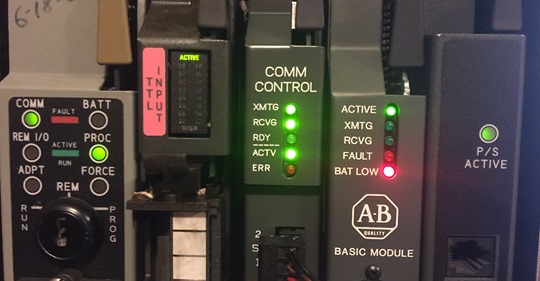Introduction to Training for Allen Bradley PLC-5 with RSLogix
It’s getting more difficult to find Training for Allen Bradley PLC-5. Anyone who has worked in industry over the past 30 years has probably worked with this processor. The PLC-5 was a very reliable, durable workhorse that is now obsolete. Even though it’s obsolete, there are still a lot of these processors in production systems, and demand PLC-5 training.
The PLC-5 has a 1970’s I/O structure, which is in the octal numbering system. Additionally, you cannot address analog modules discretely. Block Transfer instructions will transfer data from the analog modules to another memory location where you can access it with the user program.
Another key point is that the PLC-5’s memory locations are based on addressing. Conversely, modern systems such as ControlLogix base memory locations on more user friendly tag names.
In this post, I’ll outline a training program for the PLC-5. The instructor will customize the class depending on your training needs.

PLC-5 Hardware
The PLC-5 Hardware consists of the backplane, I/O modules, a processor, and a power supply. The students will learn the addressing scheme of the I/O modules. Additionally, they will learn the purpose of the status lights, dip switches, and how to troubleshoot power supply issues.
If you provide a schematic, and a PLC-5 program, the instructor will use these as examples throughout the entire training. That way, you are sure that what the instructor is teaching applies directly to what the students need to know.
Addressing for the PLC-5
A big stumbling block to those troubleshooting PLC-5 systems is the addressing structure. Keep in mind, the addressing structure is in octal. In other words, there are no 8’s or 9’s in the addressing. Not only does this apply to the I/O modules themselves, but also to the rack and group numbers.
Students will understand the difference between 1-slot, 2-slot, and half slot addressing. Additionally, they will be able to locate memory locations in the program that relate to field devices on your schematics. After that, they will be able to navigate through the program. They will determine conditions necessary for a field device to energize.
Communications Training for Allen Bradley PLC-5
Another problem many technicians have is communicating with the PLC-5. In class, they will learn how to configure communications drivers in RSLinx. This includes, DF1, Data Highway Plus (DH+), and Ethernet. They will learn how to troubleshoot communication issues, and how to maintain a proper network.
They will learn how to backup the known working driver configurations, and how to restore them at a later date.
PLC-5 Instructions
Basic instructions include “Examine On”, “Examine Off”, and “Output To Energize”. These are the fundamental building blocks for ladder logic. They will also learn about latches, seal-in logic, and one shot instructions. They will add these instructions to logic to understand their operation, and know when an instruction is true. We will also cover internal bits (B3), and how they represent the fact that certain conditions are true. Students will practice navigating through logic to determine why an output did not energize.
The PLC-5 also supports three types of timers: On-Delay (TON), Off-Delay (TOF), and the Retentive Timer (RTO). They will understand how each instruction manipulates the Enable bit (EN), the done bit (DN), and the timer timing bit (TT).
Additionally, counters will count false to true rung transition. Not only will this count product, but they are also useful for troubleshooting. Imagine a machine with safety gates. If one of the gates are intermittent, and shutting your system down, the technician can simply place a counter on each gate switch. The next time the problem occurs, they can see which switch caused the transition as well as how many times the problem occurred.
Analog
The PLC-5 allocates 16 bits of input and 16 bits of output per module group. An analog module will typically have 16 inputs (or outputs) plus some status words. In other words, the analog data will not fit onto the discrete table. For analog, the PLC-5 uses block transfers. These block transfers are intimidating to those who are not familiar with them.
In class they will become familiar with how these block transfers work, and what data tables they are using. With this knowledge, they will be able to find the data table sent to or received from any analog module in your system.
Troubleshooting Training for Allen Bradley PLC-5
There are several key features of RSLogix 5 that aid in troubleshooting your system. These tools include a custom data monitor (CDM), Histogram, Trending, and Advanced diagnostics. In class, they will have a few hours of practice with troubleshooting where they can utilize these tools.
By the end of the class students will be able to locate outputs that will not energize. They will be able to navigate through the program to find the conditions for the PLC-5 to call for the outputs.
Summary of Training for Allen Bradley PLC-5
In short, by the end of the class, students will have the knowledge that they need to troubleshoot your PLC-5 systems. We will base the training on your own plant programs, and schematics. The class will be on-site at your location for ~34-36 hours with a maximum of 10 students.
— Ricky Bryce
